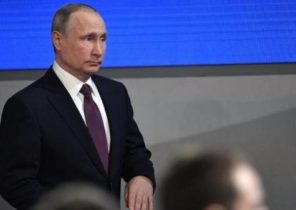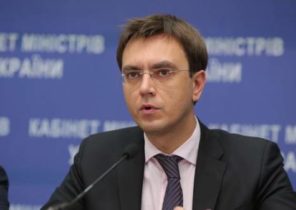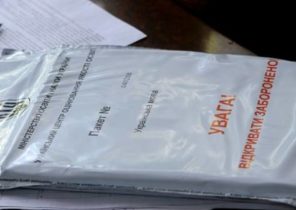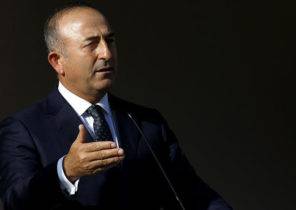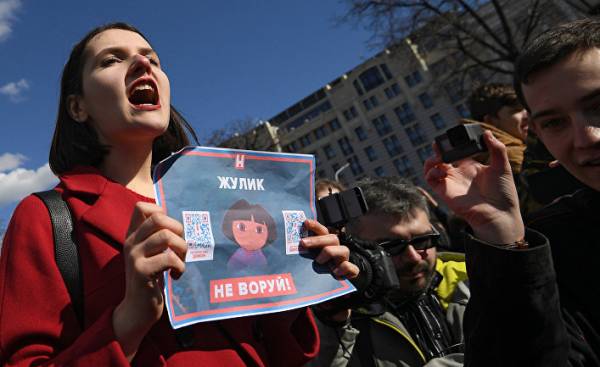
Main points:
• In Eurasia increased the number of people born after the collapse of the Soviet Union, and the region undergoing massive political and cultural change.
• In Eurasia there will be less use of the Russian language, and people in post-Soviet States will become increasingly intolerant attitude to corruption and harsh actions of the security forces, which have been preserved since the Soviet times.
• A combination of demographic, cultural, political and technological changes in the former Soviet republics will make it difficult for Russia to demonstrate its strength and influence at home and abroad.
— ——–
The collapse of the Soviet Union a quarter-century ago marked not only the end of an era but also the beginning of a new era. On the ruins of the Soviet Union were the Russian Federation and 14 independent States, which occupies a huge space in Eurasia. The former Soviet republics from Eastern Europe to the Caucasus and Central Asia suddenly acquired the possibility, at least theoretically, to conduct independent Russian domestic and foreign policy. And in Russia, despite the loss of the Empire, had the opportunity to draw a new course for its economic, social and political development.
But old habits die with difficulty. For 70 years of its existence, the Soviet Union is firmly cemented in the minds of its member countries by political and cultural habits that are extremely difficult to refuse. Its citizens used to live in a centralized political system, which was the low standard of living and the frequent cases of corruption. This trait, which became the heritage of the Russian Empire, appeared before the Soviet Union. Many of them remained in the newly independent States after its collapse. In spite of the formal rejection of communism and the command economy and the transition to democracy and capitalism, most former Soviet republics, excluding the Baltic countries have retained a centralised system of public administration and the capitalist model is adopted only in a truncated form. Russian language, meanwhile, remained in Eurasia, the language of interethnic communication. Moreover, recovering from the chaos of the initial post-Soviet period in the 1990s, Moscow has restored its relations with the countries of this region. To demonstrate its power and influence in post-Soviet Russia to this day uses a very variety of tactics, starting with the deployment of troops to political manipulation.
However, remnants of the Soviet era are starting to weaken, as higher numbers of people born in the post-Soviet period. Today, the average age in Russia is slightly less than 40 years (the same in Ukraine and in Belarus), this means that the average citizen in these countries lived under the Soviet regime, less than half of his life. And in Central Asia, where the median age of the population less than 30 years, only half the people know what the Soviet life. It will take only two decades, and most of the population of Eurasia is not the direct and immediate memories of the Soviet Union. These demographic changes promise to transform the former Soviet state politically, economically and culturally, challenging Russian influence in these countries.
The change of generations in Eurasia is already beginning to affect. So, in this region is used less and less Russian language. Many former Soviet States are not paying much attention to it, while in the Soviet era, it was taught everywhere and always. Today from students of most educational institutions in Eurasia do not require knowledge of the Russian language. There is studying in the national languages. Moreover, as international students increasingly learn not Russian, but French, German, English or Chinese. The use of Russian as the main language, too, is on the wane in most parts of the post-Soviet space. According to Euromonitor, which has used information from the UN and national statistical authorities, if in 1994 the Russian as the main language, used to 33.9% of the population of Ukraine, then in 2016 this figure amounted to less than a quarter. In Kazakhstan during the same period the figure dropped from 33.7 to 20.7%. And in Georgia, Russian as the main uses just 1.1%, while in 1994 this figure was 6.4%. Of course, most of the population in these countries, including the younger generation, understands the Russian language and speak it as a second. But in General they are less.
Within this trend, some countries in Central Asia and the Caucasus switched from the Cyrillic to the Latin alphabet. Turkmenistan did it shortly after independence. The same thing, although less successfully, in the early 1990s, made in Uzbekistan. Now there are two systems of writing. Now these countries acceded to Kazakhstan, decided to create his own alphabet. In April the President of Kazakhstan Nursultan Nazarbayev has published an article that said that by 2025, all books and official documents in the country are printed in the Latin alphabet. The Nazarbayev administration is thinking about this transition in the early 1990-ies, but now, when Russian language in this country is used less frequently, and Kazakh increasingly, such changes become almost inevitable. And over time language changes in the Russian periphery will weaken the cultural influence of Russia in these countries.
Political change
Meanwhile, Russia has to take into account the more pressing threats, not only in the traditional sphere of influence, but within its own borders. Post-Soviet generation in Eurasia belong to their national authorities as their Soviet parents and grandparents, and Vice versa. Before Mikhail Gorbachev in the late Soviet era started to implement reforms, criticism of the authorities, and the more public protests there was virtually no, and that there were serious reasons. To disagree with authority, both real and apparent, the government responded with arrests, deportations and executions of mortals. Gorbachev’s policy of glasnost and perestroika were first allowed to question Soviet policies and conduct demonstrations. But the government still strictly controlled any protests and suppressed them with the help of the security apparatus, often using force. When the Soviet Union disintegrated, emerged in its place, independent States had to develop their own policies in respect of open dissent and discontent. Many post-Soviet States in Eurasia (again, excluding the Baltic countries) held a hard line against the protesters, suppressing their security forces and carrying out pre-emptive arrests in an attempt to contain the opposition and activists. Large peaceful demonstration in Eurasia in 1990-e years were a rarity.
The situation began to change in the mid 2000-ies, when in Eurasia, a wave of revolutions. Mass protests against unpopular governments and disputed election results in 2003, led to peaceful change of power in Georgia. Her for two years, followed by Ukraine and Kyrgyzstan. So-called color revolutions did not go to any comparison with the early 1990s, when the country regained independence. Caused popular discontent, not the decisions of the highest echelons of the Soviet system. In the next decade, dissent began to use force. In 2010, the unrest has spread to Kyrgyzstan, when the society rose to overthrow a corrupt leader, staged nepotism in the government. Four years later, the demonstrators took to the streets of Kiev, protesting against the decision of the Ukrainian government to abandon the Association agreement with the European Union. When security forces became aggressive to suppress the protests on the streets of hundreds of thousands of people, mostly students. The protests escalated into violent clashes, as the government refused to resign and hold early elections. In the end, the Euromaidan movement overthrew President Viktor Yanukovych and his administration.
Demonstrations in Kyrgyzstan and Ukraine have shown that people in these countries are no longer willing to tolerate blatant corruption and violent actions of the security forces, characteristic of the Soviet era. Several years passed, and the mood spread to other countries in the former Soviet Union. In Eurasia there is more and more protests against economic stagnation and government corruption. Take as an example the recent protests in Belarus. In February and March, thousands of people across the country openly expressed their dissatisfaction with the economic situation in Belarus and actions of the government to fix it. Such a scale demonstrations and persistence of their members a few years ago would have been unthinkable, because President Lukashenko is taking strict measures to ensure security. But the protests continued for several months, although the authorities tried to detain the demonstrators, using harsh measures against activists and opposition organizations.
Russia also was not immune from unrest. After less than 20 years of political stability and economic prosperity under President Vladimir Putin, the Russian people expect a certain standard of living. The downturn in the economy and corruption scandals of recent years have become increasingly unacceptable to the Russians, especially for young people. People in April began to organize mass demonstrations in cities throughout the vast territory of Russia. These protests were notable in that they were held in a large number of cities, and that they received an overwhelming number of young people slightly older than 20 years.
A significant role in the demonstrations was played by new technologies. Young Russians are communicating and organizing various events and promotions using the Internet and social networks. (Social networks have become so important geopolitical tool that the Ukrainian government this month blocked the Russian platform “Vkontakte” and “Classmates”, referring coming from them threats to national security.) Russia, like Belarus, takes harsh measures against social networks and against the demonstrations, but the authorities becomes increasingly difficult to control the protest movement by traditional means.
Looking ahead
Meanwhile, in most parts of Eurasia state managers continue to feel an attachment to the Soviet era and its order. As a result, relations between authorities and citizens will become more tense and unstable. Especially this fight will be in Russia, which is facing a demographic decline, but also cultural and political change. The population decline in the country weaken its economic and military positions in comparison with other powers, vying for power and influence in Eurasia. According to UN projections, by 2050 the population of Russia will shrink from 143 to 129 million people, i.e. almost 10%. Unlike Russia, the US population is expected to increase by 20 percent. It also will significantly grow in Turkey and Iran. (The major countries of Europe will be somewhere in between Russian and American figures.) Moreover, with the reduction in the total population, the share of Slavs there will steadily decrease, which will further affect the cultural and political consciousness of Russians.
The challenges, which Russia faces at home and abroad, will stop her to show his power and influence in the post-Soviet periphery, and to maintain order and stability within its borders. Undoubtedly, the country will adapt to some cultural, social and technological change, but demographic and language changes will harm Russia, what would be the policy it pursued neither. Thus, increasing the post-Soviet population in Eurasia Russia’s position as the dominant power in the region will increasingly weaken.
